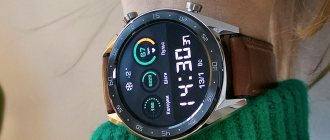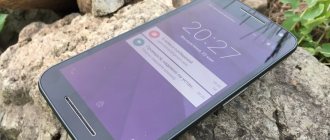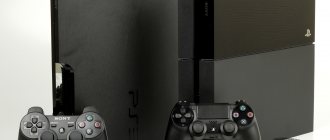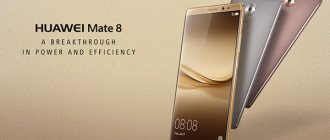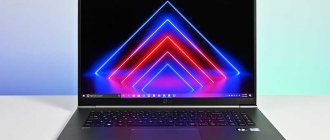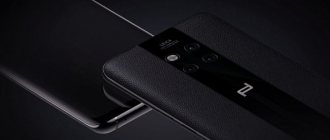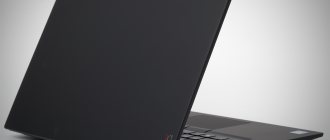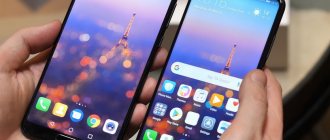Equipment
The solid black box made of thick cardboard contains a microUSB power cable, a 5V and 2A adapter, a simple headset, a special clip for removing the SIM card and, of course, the Mate 7.
The packaging as a whole is tasteful, high quality and creates the feeling that this is an expensive item. The accessories do not make such an impression: ordinary little laces made of white plastic. Go ahead.
Design and ergonomics
The first thing that catches your eye is the frame. They are thin (about 2.9 mm), and the screen occupies 83 percent of the entire area of the front side of the smartphone. For comparison, in the iPhone 6 Plus this figure is 73%, and in the Samsung GALAXY Note 4 - 80%.
Screen area of Huawei Ascend Mate 7
Despite the fact that the engineers tried to make the case as compact as possible, the dimensions still make themselves felt. The device is big and even very big. Due to the beveled corners at the back, the Mate 7 fits relatively well in the palm of your hand.
However, it is impossible to operate it with one hand.
Due to the all metal body, it is a bit slippery. Of course, not the same as the iPhone 6, but there is still a risk of accidentally dropping the gadget.
Metal case Huawei Ascend Mate 7
I propose to immediately compare the dimensions of our hero with his main competitors:
| Length | Width | Thickness | Weight | |
| Huawei Ascend Mate 7 | 157 | 81 | 7,9 | 185 |
| Apple iPhone 6 Plus | 158,1 | 77,8 | 7,1 | 172 |
| Samsung GALAXY Note 4 | 153,5 | 78,6 | 8,5 | 176 |
| LG G3 | 146,3 | 74,6 | 8,9 | 149 |
A smartphone can easily replace a tablet, if you do not use the latter as a work tool. However, the taste and color, as you know...
The main part of the body is machined from a single piece of metal. On the top and bottom of the back you can see that plastic inserts are used. The phone antennas are hidden under them.
The main camera eye protrudes slightly above the surface, but the fingerprint scanner platform, on the contrary, is slightly recessed.
Fingerprint's scanner
To the left of the camera is a single-section LED flash. And below, under small perforations in the metal, there is a multimedia speaker. The sound through it is quite loud. It will most likely be difficult to miss a call on a noisy street.
Speaker Mate 7
Above the screen there are the usual “senses” of any modern device: a light and proximity sensor, an LED responsible for various notifications, a front camera peephole and a speaker grid.
Front camera and sensors
Below, on the front surface there is nothing except the brand name. Touch keys are part of the interface and can be configured from the menu, as well as hidden when needed or always.
On the right side there are volume keys and a wake-up button.
Sides of the smartphone
The left side is occupied by two trays, one of which is used as a carrier for a SIM card (Micro standard), the other for a memory card.
On the top edge there is a microphone hole and a 3.5 mm audio output, and on the bottom there is another microphone and a microUSB connector.
The overall impression of the smartphone is very positive. The thing is really high quality, reliable and looks expensive. And this is Chinese, for a moment.
There are three color variations of smartphones found in nature:
We tested it with a silver model, but I recommend taking a look at the dark version. The latter looks very noble.
By the way, another version of the smartphone will soon be available in China. The word “Monarch” will be added to the name, which means there will be 64 GB of memory on board and an extended warranty. Under the latter, the user can be sure that his phone will be repaired in just one hour if any problem arises with it. The price for a VIP class ticket is set at $710. However, all this is completely irrelevant for Russia.
Huawei Mate7 smartphone review
Huawei's first phablet, the Ascend Mate with a 6.1-inch display, hit the market long before it became fashionable. The Ascend Mate was good: its screen understood the gloves, was superbly bright and decently juicy. The performance of the phablet was in line with the best traditions of an almost flagship smartphone, and its autonomy could have amazed the imagination (after all, there was a 4000 mAh battery hidden inside) if the smartphone’s processor had been more energy efficient. After Ascend Mate there was Ascend Mate2, a mid-range device announced a year ago and passed our attention. And finally, at IFA 2014, the company showed Mate7 - a phablet that, since its announcement, was waited with bated breath for review, probably in every edition of a publication about gadgets. We waited and therefore hasten to tell you about our impressions of the device.
What is this?
A flagship 6-inch phablet, which is equipped with a powerful processor of Huawei’s own design - HiSilicon Kirin 925, a FullHD display, a high-quality 13-megapixel camera, and a 4100 mAh battery.
What else is he interested in?
Huawei Mate7 supports memory cards up to 128 GB. Moreover, in the microSD slot, instead of “memory,” you can install a nanoSIM card on the back side (in MT7-TL10) and get a dual-SIM smartphone. In addition to memory tricks, the Mate7 is interesting for the presence and operation of a fingerprint sensor - a separate SmartI3 processor is used to process data from it, and all information about the user’s fingers is stored in a secure place in the device’s memory and is not transferred to the cloud or third-party applications. As a result, information is read from the sensor instantly and is reliably protected from hacking.
What does he look like?
In many respects, the Mate7 competes with the Lenovo Vibe Z2 Pro and Alcatel Hero 2. All three devices have a 6-inch IPS display, a thin metal body with minimal bezels around the display (in the Mate7 their width is only 2.9 mm) and a high-capacity battery .
The thickness of the Mate7 case is 8 millimeters, which is a good indicator. But at the moment this is no longer a record for a phablet. The smartphone body is 95% metal, but there are no problems with the operation of the communication modules; they are all hidden behind plastic inserts. The speaker, despite Huawei's successful experience in placing it on the ends of some other models, was again sent to the rear panel. He screams loudly from there, while the fabric and table muffle him.
The location for the fingerprint scanner was, frankly speaking, not the best. If it didn’t work as perfectly as in Apple gadgets, then the idea with the sensor could be called a failure. But he's good. According to my observations, in 95% of cases it works on the first try. And to unlock your smartphone when it is lying on the table, you can use a pin code. That is, in the case when you need to quickly turn on a gadget protected from the whole world, there are no problems with doing this quickly. The sensor itself is slightly recessed into the body, so there is no fear of damaging it. Having tried the gadget in action, I have to take back my skepticism about the fingerprint scanner in Android in general and in this model in particular.
The camera eye, on the contrary, protrudes from the body. But it is also additionally protected - by a small side. And when the smartphone is lying on the table, the camera does not touch the surface.
The smartphone looks great from the back. And the color of the case is interesting. And scratches do not appear on it as quickly as on this year's HTC flagships. In the photo below you can compare the design and dimensions of the Mate7 (6 inches) and G7 (5.5 inches). Despite the difference in size that is not in favor of the phablet, it fits just as well in the hand. And it feels like his body is more noble.
The smartphone immediately received a sticker on the display out of the box. And its control keys - on-screen, touch - look like in the Android 5.0 interface, although Android 4.4.2 is installed here.
Well, for a snack - side views. The button layout is standard, quite comfortable, there are card slots under a flap and a perfectionist's hell - a microUSB connector shifted slightly to the left at the bottom end.
How does he work?
The smartphone is equipped with 2 GB of RAM and a Kirin 925 processor developed by Huawei. The difference in the operating speed of Huawei Mate7 and Ascend P7 (with a FullHD display and the same amount of RAM, but with the company’s own Kirin 920 generation processor) and in the smoothness of the interface is very noticeable. The Huawei Mate7 interface works smoothly and quickly, while the Ascend P7 began to slow down under the same load. In addition, the Mate7 case heats up less. 15 minutes of Real Racing 3 or the Epic Citadel benchmark can make it warm, but not scorching, and the game will not start to slow down. I played Real Racing 3, Temple Tun 2, Asphalt 8 and Dead Trigger 2 on my smartphone and did not experience any problems with the graphics. But when installing a couple of dozen applications on top of all existing desktops, the desktops can be flipped with a twitch; this is a characteristic feature of almost all Android smartphones, even in flagships it has been noticed. In performance tests, the Kirin 925 is not a record holder, but in real life the Mate7 has no problems with performance.
How long does he work?
The Mate7 has a 4,100mAh battery, but with its large and bright display, the impressive battery is capable of delivering a typical day and a half of battery life under average use for a pricey device.
What's with the display?
I am skeptical about displays with a resolution of 2K (2560x1440 pixels) in smartphones, so I accept with joy the fact that Huawei did not follow the technology race and installed “just” a FullHD screen in its smartphone. At 6 inches, the difference between 368 ppi and 490 ppi is not noticeable to the eye. But the performance of a 2K device would be significantly affected. The display quality of the model is not bad. The brightness of the white field is 394.85 cd/m2 (that is, in the summer under the sun it will be readable), the contrast is almost 1000:1. The color temperature is 1500K cooler than the standard, but this is not a very critical deviation. You can turn it down in the screen settings, although along with the temperature the brightness will also decrease somewhat.
Among the negative aspects, it is worth noting that it is very difficult to find support for working with gloves in the menu, although it is there, it is not in the “Screen” section, but in the “Control” section, in the same place where you can enable the “In a case” mode and one-handed control mode.
What's interesting about the new EMUI 3.0?
Out of the box, Huawei Mate7 runs Android 4.4.2, on top of which it uses the proprietary interface - EMUI - in its latest incarnation, version 3.0. The interface does not have a separate application menu, as in all Huawei. The first thing that catches your eye is the overall consistent design style (you can choose one of several themes in the settings, and they will all look stylish). The icons of all third-party applications that are installed on the device immediately take on a square shape and do not deviate from the general style. The corporate fonts here are thin, all the icons in the interface are also displayed in neat thin lines.
The notification panel looks unusual. Here everything is divided into “icons” and “notifications”, unlike the typical “curtain” of an Android smartphone, where everything is in a common heap. Notifications also look special - for each of them the time of occurrence of the event is indicated, all the inscriptions are large and easy to hit with a finger (which is not always found in branded interfaces).
The settings, as is customary with Huawei, are divided into general and that's it. You need to set up fingerprints and turn on the pedometer in “all”, and you can adjust the font on the screen in “general”. The pedometer itself is purely a pedometer. Similar to Google Fit, but it doesn’t even show the distance.
The screen unlock setup process is as follows.
Another noticeable change in EMUI 3.0 is the settings for power-intensive applications, which are hidden in the “power saving” section, and memory cleaning settings. Here you can track which services are eating up how much of your precious battery and, depending on their need, turn it off or put up with it. Perhaps no other competitor has such fine tuning. But, I must admit, I used it only for work purposes; I most likely wouldn’t change anything for myself. Still, a day and a half of autonomy is a sufficient result to fight for additional drops of work.
Is the camera good?
Huawei Mate7 is equipped with a 13-megapixel main camera and a 5-megapixel front camera. Both cameras are good in low light and light twilight, and the main one can even take quite decent photographs by smartphone standards at night in city lighting. The camera also copes with macro photography with a bang, and where the HDR mode is appropriate, it turns it on automatically.
The same photographs in original resolution are available in a separate gallery on Torba.
The camera interface is minimalistic, all images in it are made in the general style of a smartphone interface - neat pictures drawn with thin lines. There are two photography modes: normal and one in which you can change the focus of the photo afterwards. Video is shot in only one mode, but the camera allows you to take photos at the same time. Right during shooting, you can apply one of the filters or apply a watermark (a “watermark” means an image with a date, location, temperature or some text, but you can only choose from a preset gallery). Everything is convenient, but unusual due to its simplicity. But there are no preset modes for shooting in different conditions in the camera.
What are its competitors?
Huawei Mate7 has three competitors, all of them quite serious. These are Lenovo Vibe Z2 Pro, Alcatel Hero2 and Samsung Galaxy Note 3. Lenovo received a QHD display (with a pixel density of 490 ppi), as well as a powerful Qualcomm Snapdragon 801 processor. True, I didn’t feel any difference in the performance of the devices in real life, everything is “surplus” in games, it takes over an ultra-precise display. Huawei can counter this with a perfectly working fingerprint scanner. If you are one of those who are afraid of losing your smartphone along with the most secret information in the world, then this device feature will be useful for you. Although, while using a smartphone, I came to the conclusion that I don’t need it. Alcatel Hero2 has not yet reached our editorial office, so I cannot draw conclusions as to how much more interesting or attractive it is than Mate7. But there is no doubt that he will be the most accessible of the four.
Samsung Galaxy Note 3 was recently recognized by the editors of gg as the most optimal phablet to buy at the moment. The fact is that no one has yet been able to repeat Samsung’s achievements in the field of working with a stylus. The S Pen can do things that its competitors have never dreamed of; it can be used to conveniently process information, save valuable publications from the Internet, quickly record data into a smartphone, and even draw something like presentations in it. But not all users need a stylus for all sorts of similar things on their smartphone. Some are ready to settle for a finger and a big screen. Personally, it seems to me that they themselves are a good reason to choose a Note line device over all competitors for the same money. But those who prefer a cool metal case to any S Pen should definitely choose Huawei Mate7. The devices will be approximately equal in autonomy, performance, speed and camera quality.
Bottom line
In the segment of phablets with powerful characteristics, Huawei Mate7 stands out for its balanced characteristics, for which you won’t have to overpay, good performance and low price (the official price at the time of publication of the review was 8,777 hryvnia). If you are looking for a good-quality phablet with a metal body, then Huawei Mate7 is worth paying close attention to.
4 reasons to buy Huawei Mate7:
- compact and stylish metal body;
- excellent autonomy;
- excellent working fingerprint scanner;
- attractive price/feature ratio;
1 reason not to buy Huawei Mate7:
- you need a cool smartphone, but smaller.
| Technical characteristics of Huawei Mate7 | |
| operating system | Android 4.4.2 KitKat |
| Display | IPS, 6 inches, 1920x1080 pixels (FullHD, 368 ppi) |
| CPU | Octa-core HiSilicon Kirin 925 (big.LITTLE, 4x Cortex-A15 1.8 GHz, 4x Cortex-A7 1.3 GHz), Mali-T628 graphics |
| RAM | 2 GB |
| Flash memory | 16 GB, supports memory cards up to 128 GB |
| Camera | 13 MP, LED flash, autofocus, video [email protected] , front 5 MP, video recording 5 MP |
| Wireless technologies | Wi-Fi/b/g/n, Bluetooth 4.0, NFC |
| Navigation | GPS, GLONASS |
| Battery | 4100 mAh (11.4 Wh) |
| Dimensions and weight | 157x81x7.9 millimeters, 185 grams |
Smartphone display
It is based on an IPS matrix with a diagonal of six inches and a resolution of 1920 x 1080 pixels. The pixel density per inch does not exceed 368 ppi. I am convinced that QuadHD is not what even a modern flagship with a similar diagonal needs. It will be very difficult to discern the difference, so good old Full HD is more than enough here. At the same time, it saves processor and battery resources.
Huawei Ascend Mate 7 screen
Viewing angles, brightness, contrast (1500:1) - everything is in perfect order. The colors are moderately rich, close to natural. Let's see how everything really looks.
From the settings, you can play with the gamma parameters: from cold to warmer shades. This is normal functionality from Huawei.
The screen is covered with a glass panel called Corning Gorilla Glass 3. The coating is actually very resistant to scratches and the accumulation of grease from fingers.
Screen
Huawei Ascend Mate 7 has a 6-inch screen made using IPS technology, with Full-HD resolution of 1080x1920 pixels and a pixel density of 368 ppi. At this resolution, you will not be able to distinguish the pixels on the screen, the images look bright, with saturated colors.
Despite the fact that the screen resolution of competing devices has already reached the Quad HD level, and is 2560 x 1440 pixels, the “low” resolution of Ascend Mate 7 allows you to save battery power longer. And in my opinion, this is a significant plus.
In general, it is worth noting that the screen has high brightness, excellent color reproduction, and good contrast.
Technical characteristics of Huawei Ascend Mate 7:
- HiSilicon Kirin 925 processor (8 cores)
- special chip Sensor Management Unit i3 (230 MHz)
- Mali T628 graphics accelerator
- RAM 2 (about 906 MB available) or 3 GB
- internal memory 16 or 32 GB (25.30 GB actually available)
- microSD memory card support (up to 128 GB)
- 6'' display with a resolution of 1920 x 1080 pixels (368 ppi)
- main camera 13 MP, aperture f/ 2.0
- front camera 5 MP
- sensors: gyroscope, light sensor, accelerometer, compass, fingerprint scanner
- microUSB 2.0 (OTG), audio jack
- lithium polymer battery (non-removable) 4100 mAh
- OS Android 4.4.2
- shell version EMUI 3.0
Networks
- 2G, 3G, 4G LTE (cat6, FDD bands 1, 2, 3, 4, 5, 7, 8, 20, 28 and TDD 40)
- Wi-Fi (802.11 a/b/g/n), Bluetooth 4.0, NFC, no infrared sensor
- aGPS / GLONASS
Any flagship needs the very best processor. Here this is the HiSilicon Kirin 925, which is based on 4 CortexA15 cores operating at 1.8 GHz, as well as four less productive CortexA7 cores clocked at 1.3 GHz.
Processor Huawei Ascend Mate 7
In addition, this system on the chip also has:
- Sensor Management Unit i3 coprocessor, responsible for processing data from various sensors of the device,
- graphics based on Mali T628
- additional HiFi3 core working with audio stream
- network modem supporting LTE (Cat 6)
- RAM LPDDR3
- separate camera and display controllers
- as well as an area that supports hardware-level encryption
It is reported that big.LITTLLE 8 technology provides the HiSilicon solution with a 15% performance increase compared to the Qualcomm Snapdragon 801 and 20% greater energy efficiency. By the way, our hero’s brains are built using 28-nanometer technology.
On the back side there is a fingerprint sensor that recognizes fingerprints (up to 5 pieces) in any orientation. You can place your finger upside down, on the side, or in some other way - recognition will occur correctly and very quickly. The sensor works great. Engineers have worked hard on this.
But what else can be said about the configurations. The gold model of the smartphone, in addition to a slightly higher price (we'll come back to this later) and the corresponding color, can offer the owner 3 GB of RAM, 32 GB of internal storage and support for two SIM cards (Nano SIM is responsible for LTE networks). Personally, I liked the dark variation the most, and I would like to have the specifications as in the Premium model. What a dilemma!
Description
Design
The smartphone looks really very cool. Aluminum is used as the panel material, which is certainly a very pleasant plus. The phone is very thin, only 7.9 millimeters, and the camera protrudes, just like the latest iPhone.
Huawei Ascend Mate 7 cannot be called a compact device, because its screen diagonal is as much as 6 inches. For this reason, you should not expect elegance from it, but it has many interesting technical solutions. For example, it is on this device that the fingerprint unlock function is most conveniently implemented. The sensor is located at the back of the phone, in the place where your finger usually rests when gripping. And most importantly, the screen is immediately unlocked, that is, no additional buttons need to be pressed. Of course, with this scheme, false positives are possible, but they are quite rare.
Display
The display is one of the strongest points of a smartphone. He's good at almost everything. There are maximum viewing angles, a large diagonal, and the manufacturer did not overdo it with the resolution, leaving the usual and, in our opinion, the most successful - FullHD. Also, such already established options as the absence of an air gap, anti-reflective and oleophobic coatings have not gone away. But all this is used in almost any smartphone that costs above average.
The main feature of the display is the matrix, which is simply amazing.
The maximum screen brightness is 500 candelas per square meter - this value will allow you to use your smartphone completely comfortably even in bright sunshine. Contrast is also excellent.
Overall, we really liked the display. Of course, it has one drawback, in the form of a slightly unfinished color temperature, which slightly leans towards warm tones, but compared to its competitors this is really a minor issue.
Performance and hardware
No, it’s not surprising that the Snapdragon 801, so popular this year, is not used as the heart of the system. Instead, Huawei uses a processor of its own design - Kirin 925. It is not so different from its predecessor - Kirin 925. It is also based on the ARM big.LITTLE architecture, has eight cores - four productive and four energy efficient, and they can be used in absolutely any combination.
In addition to the main processor, another one is used here - Smart i3, which is responsible for sensors (previously we could see a similar solution in the iPhone). Performance is at a very high level, but the phone is still inferior to the iPhone 6 Plus.
With the graphics component, everything is not entirely clear, the manufacturer claims that the device has a Mali T628 MP6 graphics accelerator, but in this case its performance should have increased significantly compared to Huawei Honor 6, but this does not happen - the performance is of course higher, but not significantly .
As for assessing performance based on my subjective impressions, Ascebd Mate 7 generally behaves quite quickly, but sometimes some unpleasant slowdowns are noticeable, which a flagship simply should not have. Perhaps it's a matter of firmware, because the review is based on a pre-production sample. Most likely, by the time mass sales begin, the manufacturer will correct this annoying situation.
Battery and autonomous operation
Despite the thinness of the phone, the designers managed to equip it with an incredibly powerful battery with a capacity of 4100 mAh. It’s immediately clear what the engineers were betting on. If you put the phone on the table and practically do not make calls from it, then it can live in this mode for more than a week. But we are not interested in such tests; we need to know how it will show itself in the usual model of user behavior. It is quite difficult to carry out such tests, but we can say for sure that even if you don’t let it out of your hands and load it all day, it will survive until the evening in almost any scenario.
Camera
The camera in this device is the only thing that the designers approached without much enthusiasm. This is the most ordinary thirteen-megapixel module, without any special interesting “tricks” or “bells and whistles”. The pictures are quite high quality, but they are much inferior to the pictures taken on the LG G3. Portrait camera – 5 megapixels, perfect for self-portraits and for posting photos on fashionable Instagram. There is nothing more to say about the camera.
The proprietary shooting application is designed in a rather minimalist style. Many additional settings are hidden deep inside, but the most frequently used ones are left in prominent places.
Performance
Let's start with the ratings of various system tests, since there is a lot to look at here.
Yes, the figures are very high - at the level of flagships in the second half of 2014, unless, of course, you count OnePlus One, which was announced in the spring. However, the same Samsung Galaxy Alpha or even Lenovo Vibe X2 score approximately the same number of points, although they cost an order of magnitude cheaper.
In general, everything is very relative and only one thing is clear: Mate 7 is still a high-performance, modern smartphone.
When it comes to gaming, there are no surprises here. All modern toys run at maximum settings without any problems.
However, at high graphics settings in the same Asphalt 8, the smartphone could perform better.
No, there are no brakes, lags or other troubles, but the picture is still not 100% smooth. About 85-90%, let's say.
System optimization plays an important role. Considering that Huawei programmers have no problems with this, the updated EMUI 3.0 shell is perfectly debugged here. I didn't notice anything criminal. Everything flies and flutters as it should. However, one day the device turned off the moment I went to Google Play. Anything can happen.
Front-camera
The front photo sensor is capable of taking pictures with a resolution of 5 megapixels or 2592 x 1952 pixels, and can record video in Full HD format. By the way, there is an F 2.4 lens installed here.
Front-camera
Additional shooting modes include the ability to create photos with sound, attach information about the current weather and date to the frame, and also take panoramic selfies. It's fashionable, there's no escape.
There are a lot of ways to photograph your loved one: shooting by tapping on the screen, releasing the shutter on a timer, when a smile is detected, voice control, and so on. It is worth mentioning separately that the fingerprint scanner can serve as a touch key for taking pictures. We have already encountered this in our review of the Samsung GALAXY Note 4. This is a convenient feature that is worth adopting.
Communication with the outside world
| LTE Band | 1-5,7,8,20,28 |
| WiFi | 2.4+5 GHz |
| Bluetooth | 4.0 |
| USB modes | MTP + Storage |
| USB-OTG | + |
| MHL | + |
| NFC | + |
Everything is there, everything works as it should. And LTE, and Wi-Fi and everything else. I didn't notice any problems.
iXBT in its review writes about the not very correct operation of MHL (the image is scaled and distorted). I didn't find this in myself. Everything was displayed clearly on my TV, as it should, and without distortion.
Ascend 7 main camera
Photos are obtained with a resolution of 4160 x 3120 pixels, in other words 13 megapixels. The lens aperture value is F 2.0.
Main camera 13 MP
I liked the quality of the output photos. The camera may not be the best in existence, but it’s definitely one of the best. He won't fall flat on his face.
An archive with photographs for detailed study can be downloaded here.
This is what a 100% crop looks like:
The pictures come out very decent even in low light conditions. Especially for this, I conducted a test at various ISO values in a dark room with the device mounted on a tripod. Let's look at an example...
The preset modes include retouching portraits, creating panoramas, applying ready-made filters, and more. There are few scenarios, but everything is compensated by the settings.
For better frame saturation, you should use the HDR setting; in addition, the parameters set ISO, white balance and adjust the brightness, saturation or contrast of the picture. In conditions of cloudy winter weather in Russia, this opportunity will not be superfluous.
The device is capable of recording video in 1920 x 1080 pixels at 30 frames per second. And there is a functionality failure here. Firstly, the smartphone is not capable of shooting 4K video, and secondly, there is no recording of videos at an increased frequency of 60 or 120 fps.
Among the additional parameters, there are only tracking autofocus and image stabilization function. By the way, the last one was not useful to me. The videos are already smooth and look pretty decent. Let's look at an example.
Camera
Huawei Ascend Mate boasts an 8 megapixel main camera module with flash and autofocus and a front camera with a resolution of 1 megapixel.
The camera app launches at average speed. It greets the user with a moderately simple interface, not oversaturated with unnecessary settings. In addition to the standard photo/video switches and shooting buttons, the autofocus tracking key is located on the main screen. On the left, a menu with additional settings for shooting modes, color filters, and various distortions for shooting “funny” portraits is pulled out. Similar settings are available when shooting videos.
The camera demonstrates good image quality, at the level of smartphones in its price category. Photos taken outdoors are of good quality, with sufficient detail. When shooting indoors, the camera may make mistakes in setting the white balance. The maximum resolution of recorded video is 1080p. You can enable autofocus tracking while recording video. The front camera is suitable for communicating on Skype. In terms of photo quality, the Huawei Mate cannot be called an advanced camera phone, but its capabilities are sufficient for the average user. Below you can see for yourself examples of photos and videos taken with this smartphone.
Examples of photos taken with the HUAWEI Ascend Mate smartphone
Example of Full HD video shot by HUAWEI Ascend Mate smartphone
Multimedia
The sound quality of the headphones is quite comparable to that of competitors. However, due to the improvement of DTS (Digital Theater System), the sound stream is somewhat expanded. You can only notice the difference by comparing the quality directly with one of the competitors. In my case it was the iPhone 5S, which, by the way, lost in this regard to the Mate 7.
The music player is very ascetic in terms of functionality. There is support for playlists, sorting tracks by various criteria, and auto-switching off playback after a specified period of time. That's probably all.
The video player is even simpler. Pause, rewind, next track - nothing more interesting.
Audiophiles will be interested in the list of supported formats:
- MP3, MIDI, AMR-NB, AMR-WB, AAC, AAC+, eAAC+, PCM, WMA
As for video, the smartphone can play the following right out of the box:
- Video codecs: MPEG-4, H.264, H.263, VP8, RV7-10, Xvid, WMV9
- Video file formats: *.3gp, *.mp4, *.m4a, *.rm, *.rmvb, *.wmv
Performance and Memory
Smartphone market leaders Samsung and Apple are independently developing mobile processors. In this regard, Huawei is trying to be no worse; it also has its own company, HiSilicon Technologies, which produces processors. It was her brainchild, the K3V2 system-on-chip, that became the heart of Huawei Ascend Mate. This SoC includes four Cortex-A9 cores operating at 1.5 GHz and a Vivante GC4000 graphics processor. It is made according to the 40 nm process technology. The amount of RAM is 2 GB, the built-in memory is 8 GB, it can be expanded using memory cards.
In general, the system works quite quickly. Working with the interface, launching applications - all this happens quickly. A large amount of RAM allows you to keep many programs running; directly from the list of recently running applications you can find out how much RAM is occupied and close all background processes with the press of one key. But in games everything is a little worse. Since the GPU is not the most common, there may be compatibility issues. For example, the Real Racing 3 installed for testing was terribly slow when navigating through the menus, but in the races themselves everything worked perfectly.
The second unpleasant moment is the heating of the case. First of all, it is due to not the most modern technical process. Slight heating can be observed even during normal operation; under load it increases. For example, during the AnTuTu Battery test, the case heated up to 52 ⁰C. Since the body of the device is plastic, it does not become scalding hot during normal use.
Below you can see the benchmark results:
The GPS performance was not satisfactory - Huawei Mate quickly finds satellites and connects to them. The speed of data exchange via Wi-Fi is average; a couple of times the smartphone lost connection with the router.
Ascend Mate 7 battery life
The device has a very capacious lithium-polymer battery with a capacity of 4100 mAh. Not bad, right? With moderate use, namely: two hours of Internet via Wi-Fi, constant notifications via 4G, taking a couple of dozen photos per day, the device will definitely last one and a half to two days. Daily charging is only needed if you are an avid gamer or a fan of watching a couple of episodes of some TV series on your phone screen.
Due to its capacious battery and good optimization of energy consumption, the smartphone can be ranked among the longest-lasting mobile phones currently available.
For the user, information on battery life consumption is presented in a convenient form. The system can independently analyze energy-intensive software and offer to stop something in the name of saving energy.
Of course, there are energy saving modes: normal, smart and economical. The latter involves switching the device to only calls and SMS mode.
Software features
The OS used is Android 4.4.2 with the proprietary EMUI 3.0 shell pre-installed. The latter has recently been updated and has become very stylish. Minimalism, good customization of appearance (themes, icons, fonts), ideal smoothness of animation - all this is about the latest version of the software add-on.
The appearance of the system is a bit like that of the LG G3. True, the Koreans have everything flatter, while Huawei, on the contrary, is lively and focuses on animation.
Support for a branded case has now appeared in the menu. When the accessory cover is closed, only part of the display is active. And the case itself looks like this:
Case for Huawei Ascend Mate 7
Considering that the smartphone turned out to be very impressive in size, the manufacturer has provided for the possibility of using it with one hand. To do this, you must activate the corresponding script from the parameters. The device can be tilted in the desired direction, and the keyboard will jump to the edge of the display.
Huawei programmers decided to equip the device with a small step counting utility. The functionality is minimal: tracking movement and displaying status in the notification panel. There is no need to download anything, the pedometer is already installed.
I will not examine the system in detail here, since this has already been thoroughly described by me in my review of the Huawei Ascend G7. Almost all the settings are identical to the flagship Mate 7, so I highly recommend reading this section in more detail. The shell is really very interesting and the Chinese have something to be proud of.
Operating system and other software
Operating system Android 4.4.2 KitKat plus proprietary shell Emotion UI 3.0.
Everything is quite ordinary, familiar and convenient. Traditionally, Huawei does not have a single list of applications, so you have to make at least minimal efforts to put order on your desktops.
There are not very many pre-installed third-party applications - Opera, VKontakte, ivi.ru, Polaris Office, Yandex search. Everything is quietly deleted except (surprise!) Opera.
Screenshots (12 pcs.)
A few words about the pedometer. There is such a pre-installed software there. More precisely, not even pre-installed, but “sewn” into the proprietary shell. You turn it on and the smartphone starts counting your steps. Convenient, funny, really liked it. The only thing is that it’s a pity that it doesn’t keep history, only for yesterday and today.


